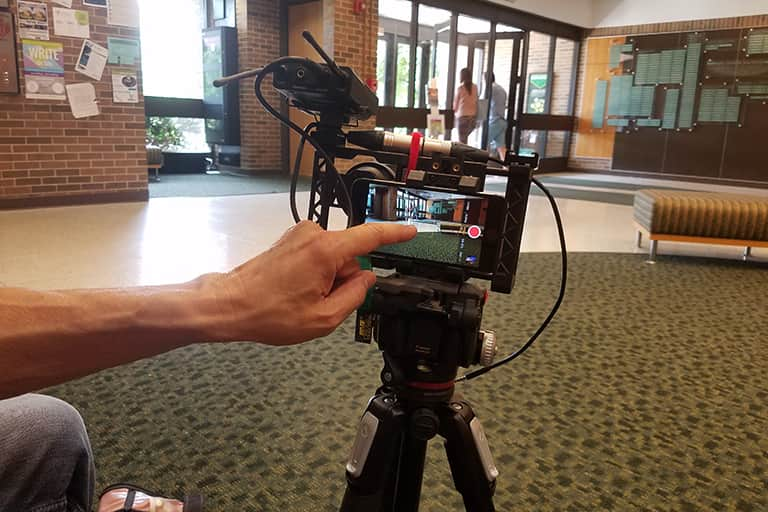About four years ago, then-reporter Mike Castellucci walked into a news interview with only two pieces of equipment — a microphone and his cell phone.
After assuring the visibly underwhelmed interviewee that he was indeed the reporter from Channel 8 in Dallas, Castellucci filmed, produced, wrote and edited his first iPhone news segment. His iPhone work would soon gain him worldwide attention and industry recognition, including two Edward R. Murrow awards, an Associated Press award, the TEGNA Innovative Storyteller award and 22 Emmys.
The Digital Landscape
With the prevalence of social media and the ability to instantly record and share news on various platforms, Castellucci, Journalism Video News Artist in Residence, says that today, everyone is a journalist.
“A tragedy happens and you will see it from hundreds of people,” said Castellucci. “Are they using it like I am? Not yet, but maybe that’s coming.”
While everyone can be a journalist, that doesn’t mean that everyone can be a good one. Castellucci has figured out how to use the technology readily available to him in ways that no one else had previously thought possible.
“We can all recognize video from our phones,” said Castellucci. “Why is that? Because it’s always shaky and we’re always behind the camera so the audio isn’t very good. If you just take layers of perception and put the phone on a tripod, put a nice microphone on it, write a good story and shoot it like you would be shooting a documentary or a news program... All of a sudden those layers of perception add up.”
Castellucci has mastered keeping his tech accessories to a minimum. Instead of a two-person camera crew, Castellucci creates his stories with a lighter load. He uses a BeastGrip smartphone rig and wide angle lens, a microphone and a small tripod that he refers to as his “poor man steady cam,” as it adds weight and steadies the camera, giving the overall video a more professional quality.
A Storytelling Pro
While technology might be continuously evolving, Castellucci says that the one thing that won’t change about the news industry is the importance of storytelling.
“I think the news business got away from storytelling in the ’80s and ’90s,” said Castellucci. “They were too concerned with automobile crashes and murders. But all anybody wants is a story. It could be a hard story, consumer story, feature story or profile, but if it’s not interesting, if you can’t write an engaging story, if it’s not emotional, then it’s just flat.”
Castellucci is putting his storytelling capabilities to the test while working on his third Phoning It In show. This time, the theme is small towns. The finished project will include segments on Golden Harvest in Old Town, Lansing and the Steam Railroading Institute in Owosso (which just won an Emmy) with the idea that every small town has a story. The show will air in all of the Texas markets and on WKAR in the near future.
At ComArtSci’s J-School, Castellucci teaches students about iPhone broadcast reporting, writing, interviewing and hosting. Ultimately, he hopes that his students will see their cell phones as more than just a social media gadget.
“I just hope they come away with a better knowledge of how to view it as a broadcast instrument and not just the thing that’s constantly in their pocket,” said Castellucci. “I want them to be able to tell stories with it.”
By Kaitlin Dudlets
